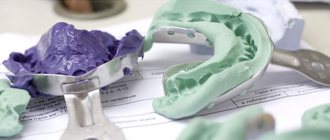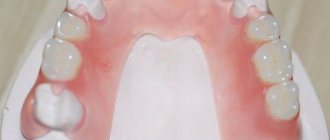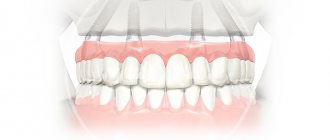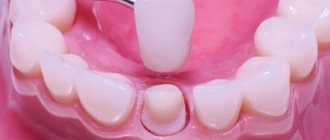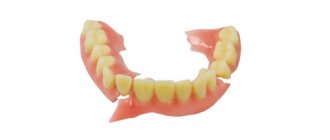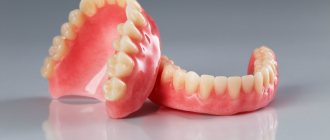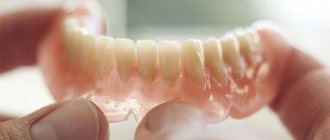Children's dental prosthetics is an opportunity to quickly restore a damaged, lost or missing primary or permanent bite unit. The dental procedure takes 20-40 minutes and is suitable for children of almost any age.
Any tooth loss before the child reaches 6 years of age is considered abnormal and requires urgent solution to the problem.
The lack of timely prosthetics leads to problems with chewing and speech, and provokes the development of bite pathologies.
Why does a child need dentures?
Many parents think that there is nothing wrong with a child missing several teeth until the permanent ones appear. However, ignoring the problem leads to dysfunctions of the child’s body:
- difficulties in sound pronunciation. The teeth are involved in the formation of sounds, the child will adapt and after the radical elements grow, he will begin to pronounce words incorrectly - a speech defect is obvious;
- gastrointestinal diseases - poorly chewed food, injures the mucous membrane of the organs of the system, leads to the development of local diseases, poor absorption of useful components;
- malocclusion - when a child loses a tooth early, other chewing units take its place, the molar has nowhere to grow - it grows out of the row. The result is that a malocclusion is formed, an aesthetic defect and psychological discomfort appear.
A dental prosthesis for a child is designed to temporarily replace the missing element and help avoid unpleasant consequences.
Crowns
Like all children's orthopedic structures, they can be of two types:
- Permanent.
- Temporary.
The latter can be fixative or preventive. They are used when a corner or cutting edge of a tooth is broken off as a result of trauma, to fix the therapeutic material. They are also used to fix devices for various dental defects to prevent tooth displacement.
Important! When performing prosthetics with temporary crowns, tooth preparation is not performed.
Crowns are used in the following cases:
- Bruxism (teeth grinding at night).
- Restoration of permanent teeth after enamel damage.
- Restoration of carious teeth.
- Tooth restoration after pulp removal.
- Complete destruction of the tooth by caries.
- Dental injuries, etc.
When is prosthetics indicated?
Dental prosthetics in children is carried out under the following circumstances:
- the tooth is affected by caries and cannot be restored;
- the element has broken off at the level of the base, root;
- tissues affected by fluorosis;
- bone inflammation has been diagnosed, in which tooth extraction is inevitable;
- periodontitis has been identified as the cause of unit mobility;
- the child has bruxism;
- the patient has underdeveloped enamel or other local congenital pathologies.
Cases in which pediatric prosthetics are necessary
So, pediatric orthopedics is used in the following cases:
- Teeth destroyed by caries cannot be restored.
- Premature loss of baby teeth occurs. If this happened more than a year before the appearance of permanent teeth, then prosthetics are mandatory.
- If it is necessary to remove a tooth when an inflammatory process has begun in the periosteum (periostitis).
- If teeth are destroyed by fluorosis and cannot be restored.
- If after treatment of caries the tooth has an unaesthetic appearance. This is especially true for those teeth that are part of the smile zone.
Modern children's dental prosthetics has the following goals:
- Promoting proper development of the dentition.
- Normalization of breathing.
- Stabilization of proper growth and development of the jaw bones.
- Preventing jaw deformation.
- Restoring the functions of the digestive tract.
- Normalization of chewing and speech functions.
Types of children's dentures
Depending on the transferred functions (purpose), a children's denture for baby teeth can be removable or non-removable.
Removable prosthetics
The defining characteristic of the products is the ability to remove the structure without the help of a doctor, if circumstances so require. They are made from a homogeneous material or several are combined. In the practice of pediatric dentistry the following is used:
- bridge prosthesis. Needed to replace defects of considerable extent (3 or more). Typically, the product is made from different types of plastics. It is possible to use metal to create fixing elements or individual parts of the structure;
- plate prosthesis. The product consists of a plastic base and fasteners. It can be stationary or sliding. The same type of structures is effective in orthodontic therapy in correcting bite pathologies and aligning individual elements in a row;
- immediate prosthesis or “butterfly”. One-piece thermoplastic nylon base structure. This is a crown, complemented by clasps that “cling” to adjacent units and fix the prosthesis in place. Typically, such a design is installed if a child has lost one “milk jug” due to injury.
Fixed prosthetics
Fixed dental prosthetics for children is important in cases where partial defects need to be restored (the child’s tooth remains in place). We are talking about products such as:
- tab. Fixed orthopedic structures help to “resurrect” the destroyed tooth crown while preserving the pulp and tooth root. In other words, this is a volumetric filling that replaces the destroyed part of the tooth, preserving the anatomical shape of the unit;
- pin tab. Installation of a prosthesis is indicated when the nerve is damaged and its resection is necessary, as well as when the crown is almost completely destroyed and the root is preserved. The doctor fixes the pin carefully, without damaging the thin root walls. The pins are made of chromium-nickel or gold alloys, the crown is “finished” with porcelain or plastic facets;
- crown. A metal structure that replaces the crown part of a decayed tooth. In this case, chromium-nickel alloy or medical steel is used;
- Strip crown is a transparent product. It is used for injuries, carious lesions, and bruxism. The “cap” is made of transparent acrylic; the filling composition plays a secondary role.
Dental prosthetics with crowns for children: indications
Children's dental prosthetics in Moscow are performed according to indications. Each situation is considered by the doctor individually, taking into account the patient’s age, health characteristics and other criteria.
Indications for prosthetics are:
- Destruction of the coronal part by half or even more - due to injuries, caries, pulpitis.
- Non-carious lesions, problems with tooth enamel in children - hypoplasia, aplasia, fluorosis.
- Removal of a baby tooth long before the start of a change in bite or permanent one.
- Gum and periodontal diseases - loosening and loss of teeth due to periodontitis, periodontitis.
- Injuries to the teeth and maxillofacial region - severe damage, chipped enamel, complete dislocation.
- Bruxism is involuntary grinding of teeth, causing deformation, destruction, and tooth loss.
- Anomalies and malformations - absence of primordia of mammary and permanent units, cleft lip and palate and other genetic abnormalities.
- Adentia - complete or partial, caused by hereditary or objective factors.
Prosthetic dental crowns for a child will help solve the problem of missing one or more units.
What should prostheses be like for children?
Children's dental prostheses must meet increased requirements, namely:
- do not interfere with the formation of children's speech and diction;
- be aesthetically pleasing and extremely easy to use;
- do not cause allergies, do not have a toxic effect on the child’s body;
- do not injure the oral mucosa;
- have minimal shrinkage and swelling;
- be resistant to plaque formation.
It is not always possible to eliminate all the negative effects of prostheses on the child’s body. In such cases, they make a choice in favor of those products that cause minimal damage.
Why do we need plates on teeth?
Plates for correcting malocclusion in children are orthodontic devices with plastic bases. They reproduce the shape of the palate and the inner surface of the teeth as accurately as possible. This creates the correct conditions for the positioning of incisors, canines and molars when they change from baby to permanent.
Plates on teeth are designed to perform the following functions:
- expand the dental arch;
- correct the tilt or rotation of teeth;
- provide free space for growing permanent teeth;
- prevent displacement of the dentition;
- correct the size of the sky;
- regulate the growth of bone and jaw tissue;
- model the shape of the upper and lower jaw.
To carry out these tasks, screw mechanisms are built into the plate on the teeth. Their number and location depend on the individual characteristics of the bite. Also, the orthodontist can provide separate elements that will improve the position of individual teeth (that is, straighten their rotations or inclinations). The more such mechanisms and elements in the plate, the higher its cost.
Turning the screw one step frees up ¼ mm of space in the dentition. The child does not experience pain - he feels only slight pressure, which completely disappears after a maximum of 20 minutes.
For the sake of the child’s psychological comfort, the plates are usually made bright and cute, sometimes fairy tale and cartoon characters are drawn on them. Let the child think that this is a toy or decoration, and not a medical item - this way he will be more willing to wear it.
ATTENTION:
Such devices are most often prescribed to children under 12 years of age. However, adults also sometimes wear plates - usually non-removable.
Progress of prosthetics
Regardless of the type of prosthetic structure, the procedure includes the following steps:
- examination, consultation;
- diagnostics - conduct a survey, examine the child (take an x-ray);
- preparation for fixation of the prosthesis. If necessary, treat the tooth;
- taking impressions;
- product production;
- fitting and installation of the prosthesis.
Before fixing any type of product, general preparation of the unit is required - organizing professional cleaning of the enamel layer.
How to care for the plate
The removable product must be removed before eating, playing sports or intense physical activity. The product should not be removed while sleeping, as this will delay the treatment process. As for whether it is necessary to remove the device while eating, there is no clear answer: the doctor will have to make an individual recommendation. It should be taken into account that most plates can be stained by food.
The record must be stored in a special sealed container, which will be provided by the orthodontist. Wrapping the device in a cloth or paper napkin is strictly prohibited: practice shows that you are likely to break it or accidentally throw it away.
Clean the plate twice a day, after waking up and before going to bed. To do this, it will be enough to use a regular toothbrush and toothpaste. Many brands produce specialized liquid and tablets for the care of such devices.
ATTENTION:
When cleaning, you need to pay special attention to the places where the screws are located. This is where food debris most often accumulates and creates a favorable environment for the proliferation of pathogenic microorganisms.
During the day, you should rinse your mouth as often as possible to eliminate bacterial plaque that contributes to the development of caries. You should brush your teeth in the morning and evening while wearing the plate especially long and thoroughly. If tartar is found on the device, you should inform your treating specialist, and he will give advice on how to remove it.
Why is it safe to install children’s prostheses in Stokos?
The Stokos Clinic in St. Petersburg works tirelessly to ensure that young patients and their parents feel calm and comfortable within our walls. Our doctors are trusted because with us:
- reliable. Stokos Dentistry employs experienced, certified doctors who approach business wisely and never act according to a template;
- calmly. Our dentists know how to make the child comfortable with themselves and the process - parents do not have to worry about their child;
- comfortable. Our staff is always polite to those who contact us, smiling and prompt in taking action;
- inexpensive. We set fair prices for services.
Make an appointment with our doctor right now - because here, with us, sincere smiles are born!
Why do children have malocclusion?
Malocclusion in children is very common and should not cause increased concern among parents. This is not a disease, but a developmental feature, and it can be corrected quite easily. Most often, the bite is crooked for the following reasons:
- the child inherited an atypically small jaw from his parents;
- teeth erupted faster than the jaw grew;
- the baby quickly developed caries, so he had to have his baby teeth removed;
- the child often bites his lip, sucks his finger, or has other bad habits that negatively affect his bite.
Also, problems with bite occur in boys and girls who often catch colds and cannot breathe through their nose. If nasal breathing is difficult due to enlarged adenoids, the small patient has to breathe through the mouth willy-nilly, which can affect the bite.
While the teeth are still baby, you can still come to terms with the curvature of the bite. But as soon as they begin to change to permanent ones, you need to start visiting the orthodontist to prevent possible problems. The sooner you start correcting your bite, the easier and cheaper it will be to get your teeth into the correct position. Most likely, for this, the doctor will put plates on the child’s teeth.
ATTENTION:
For the manufacture of children's orthodontic plates, hypoallergenic materials that are completely safe for health are used.
Correct your bite or dental defect with invisible aligners Find out what it is
How long do you wear a dental plate?
Typically, teeth straightening plates are worn for 6 months to 1 year. It all depends on the individual characteristics of the bite, as well as the regularity and duration of wearing the product.
The period of getting used to the plate lasts about 2 weeks. First, the orthodontist makes the product according to individual measurements and shows the little patient where her clasp feet are located and how to use them. Children should learn to put on and take off the plate themselves from the very beginning. However, the less they wear it and the more often they take it off, the longer the treatment will last. Parents should explain to the child that removing the plate is only allowed for a short time.
Under no circumstances should the plate compress or injure the teeth. The force exerted by it remains minimal throughout its wearing. The child should never experience pain or suffer from constricted circulation inside the mouth. The duration of wearing is primarily due to the fact that the teeth move into the correct positions smoothly and gradually. They will then need some time to “get used to” their new places.
ATTENTION:
During the course of treatment, the child will need to be brought to the clinic for examination once every 1-2 months.
Children's orthodontic dentures
Wearing dentures in childhood is necessary to prevent orthodontic problems. A well-chosen design contributes to the correct development of the bite and the formation of tissues of the dental system.
Adentia, premature loss of teeth, creates not only psychological discomfort for the child, but also affects his physical development, creating problems of the following nature:
– adjacent milk teeth fill the space of the fallen unit, leaving no room for the eruption of permanent teeth. This leads to pathological occlusion, traumatic occlusion, damage to both dentitions;
– diseases of the gastrointestinal tract. Poor chewing of food also causes weight loss, decreased immunity, and general physiological retardation;
– respiratory dysfunction;
– change in the shape of the palate.
Mixed dentition teeth are lost prematurely due to tooth decay or trauma. In the latter case, the frontal units, on which dental aesthetics depend, are affected. This is fraught with disruption of bone tissue development and distortion of the growth of permanent dental units.

